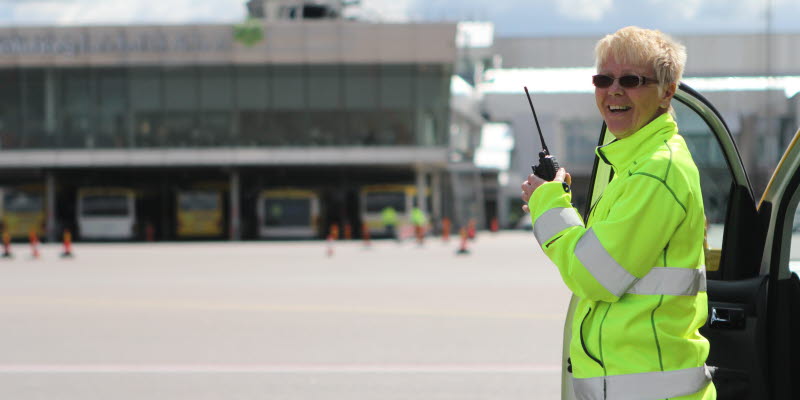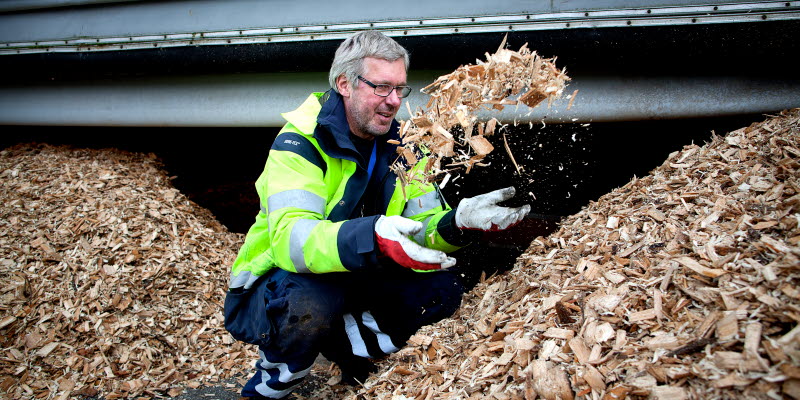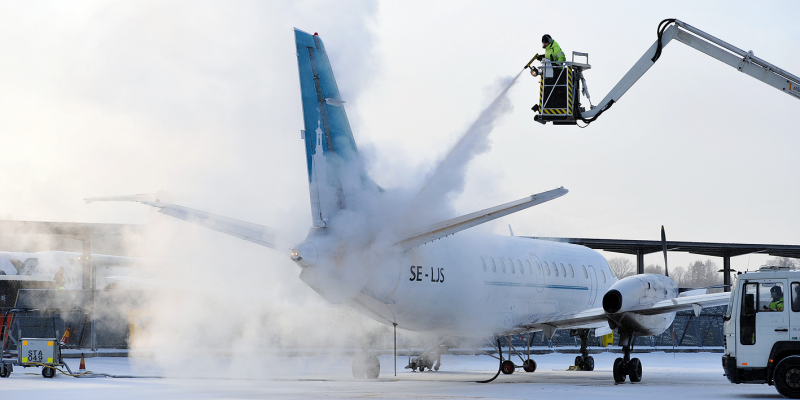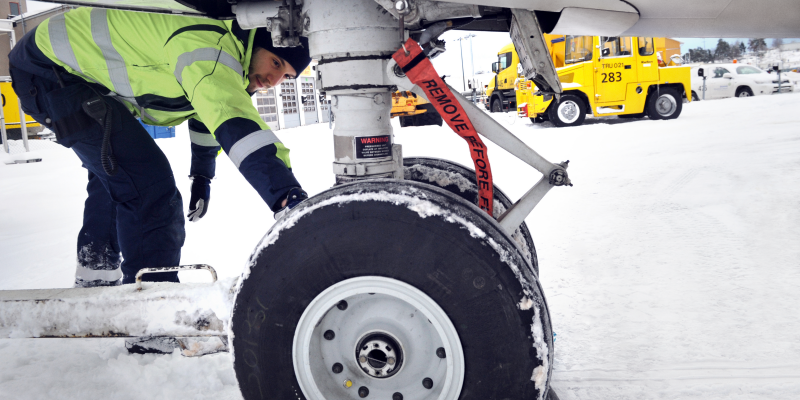Our environmental work
Swedavia's objective is to emit zero fossil carbon dioxide from its own operations after the end of 2020.

Our zero vision

To achieve the objective of zero emissions by 2020, Swedavia is carrying out a wide-ranging transformation in operations. Here are a few examples of measures that have contributed to a reduction in our emissions:
- Green electricity is purchased for all operations.
- Biofuel has replaced oil in the heating of airport buildings.
- Energy-efficiency measures are carried out while we switch over from fossil fuel.
- Fire-fighting exercises use the renewable fuel sekundol instead of jet A1.
- Environmental cars are chosen when cars are purchased or leased.
A fossil-free vehicle fleet
Renewable fuel and lower energy consumption are two key factors in Swedavia’s climate work. In order to achieve our zero emissions objective by 2020, Swedavia’s vehicle fleet plays a crucial role. So work is under way at Swedavia to replace the fossil fuel used in operations today with renewable alternatives. The order of priorities in this switchover is first choosing electric vehicles when possible, second biogas and third biodiesel.
We monitor the market on a continuous basis to choose the right approach for our vehicle fleet. A few good examples from recent work:
- New refuelling station for biogas on airside at Stockholm Arlanda Airport. The station supplies the company’s own vehicles as well as vehicles owned by other companies and organisations at airport with 100 percent renewable biogas.
- Since 2015, we have a supply contract for 100 percent HVO diesel, which meets our diesel need.
- There have been significant technological advances in different vehicles, in particular our plough, sweep and blow machines, and we have been a part of this development. Today our new PSB machines can run on both HVO diesel and biogas.
How can you as a traveller contribute?
“316 tonnes of fossil carbon dioxide were emitted from the company’s own airport operations in 2019. That is a 97 percent reduction since 2005.”
Renewable aviation fuel
A green transformation – from fossil fuel to biofuel – is already possible today. The technology is available, flights with biofuel are already flown today in a small number of places around the world. What is missing to enable more extensive use of biofuel is large-scale production and competitive prices. To achieve this, demand and political drive are needed.
Fossil-free domestic air transport by 2030
“At Swedavia today, all of the company’s air travel for official business uses renewable aviation fuel, but this also inspires other companies and organisations here to follow in our steps. Together we can create more sustainable air transport,” says Swedavia’s environmental manager, Lena Wennberg, about the fossil future of air transport.
By stimulating demand for biofuel, production increases and prices fall. In that way, we can have fossil-free domestic air transport in Sweden as early as 2030. The cost of biofuel must be reduced in order to make it economically sustainable for airlines to choose this climate-smart alternative – an alternative made, for instance, from forest waste, algae or food scraps. With ample access to forests and bodies of fresh and salt water, Sweden could also be a significant producer of this aviation fuel. That kind of development would be environmental-friendly, create important jobs and bolster the Swedish economy. Biofuel can be used in today’s aircraft engines and in existing infrastructure – so no expensive, complicated changeover in technology or infrastructure is needed.
Green flights for official business
Swedavia is the first company in the world to buy biofuel equivalent to the amount consumed in all of its air travel for official business. By leading the way and buying green flights for official business, we want to show decision-makers, companies and producers that there is a demand for biofuel in air transport and thereby contribute to large-scale production. This is an important step towards fossil-free domestic air transport in Sweden. But more players need to follow our lead.
How you can contribute
Swedavia is a partner in the Fly Green Fund, which works for a rapid increase in the demand for biofuel in Sweden. The aim is to increase the volume produced and thus bring down costs. This is to be carried out by co-funding the additional cost that biofuel entails compared to fossil fuel. The fund’s vision is for organisations and individuals to have the possibility to fly more sustainably, at a reasonable cost.
The Fly Green Fund’s customers – both companies and individual travellers – can choose how much they would like to contribute. Of the money contributed, 75 percent is used for biofuel. The remaining 25 percent is used to support development projects to start large-scale biofuel production in the Nordic countries.
As an individual traveller, you can, for instance, pay using the Swish app on your mobile phone. Companies or government agencies can sign longer-term agreements. Send a contribution for the amount you choose by Swish to: 123 131 4137
Read more about how you can contribute and buy your biofuel at www.flygreenfund.se
Climate-neutral company
To achieve climate neutrality, Swedavia buys certificates from climate projects in developing countries. These projects, called clean development mechanism or CDM projects, have been approved by the UN and are also certified under the green movement's Gold Standard for the Global Goals. The projects are aimed at reducing emissions in developing countries. As a result, Swedavia offsets the emissions that still have not been reduced through its own measures.
Energy

Including all of Swedavia’s energy consumption, for heating, electricity and cooling but also for vehicle propellants and fire-fighting exercises, 94 per cent is generated by renewable sources.
Swedavia works continuously to reduce energy consumption, and our goal is to reduce it two per cent per year compared to the average for the past four years. Two conditions for achieving this in full are that we make continuous investments in new technology and that we optimise existing systems. By making operations more energy-efficient, we can reduce both their environmental impact and costs.
Case: Read more about the world's largest aquifer storage system, which heats and cools the airport.
Objective to reduce impact on the water environment

Impact on water
Most discharges to water from the airports occur in the winter when aircraft and runways are de-iced and treated with an anti-skidding agent for aviation safety reasons. Snow and ice on the wings and stabilisers can seriously impair the aircraft’s capability to perform and in the worst case can cause an accident. Prior to take-off, aircraft are therefore de-iced with a mixture of propylene glycol and hot water.
To ensure that aircraft do not skid on take-off and landing runways, first of all field vehicles that plough and sweep are used. When this is not enough, an anti-skidding agent is used to melt ice. For about a year now, the preferred agent is potassium formate, a substance that has far better environmentally-sensitive properties than its predecessor, urea. The use of potassium formate has reduced the negative effect on surface water. This has led, for instance, to a reduced risk of eutrophication.
Environmental impact of anti-skidding treatment
Both propylene glycol and potassium formate as such have a low level of toxicity and break down easily in nature. The problem is that a lot of oxygen is used in their decomposition, so these substances may lead to a lack of oxygen in water courses if large quantities are discharged. Such discharges can also upset biological treatment processes in water treatment facilities.
During the winter, most of the glycol that runs off the aircraft is suctioned up after de-icing by dedicated vehicles. The glycol recovered is partly recycled into new glycol, broken down for the production of biogas or serves as a source of carbon in the water treatment facility’s nitrogen removal process.
The glycol that ground handling does not manage to suction up ends up in the surface water system along with the de-icing agent used on the runways. At most airports, the surface water is routed through treatment or balancing ponds, where it is treated before it reaches the water course. The surface water is also treated in oil-water separators, and there are control programmes to ensure the quality of the outgoing water.
Noise from the airports
The objective is to work so that the noise load around our airports is experienced as being acceptable relative to the social benefits of aviation. We carry out noise calculations and measurements on a regular basis to ensure that we are within the limits of the airports’ environmental permits.
Swedavia’s work to reduce its noise impact includes, among other things, insulating residences in the vicinity against noise, giving priority to airlines that use aircraft that make less noise and promoting “green” flights.
Quiet aircraft pay lower charges
Jet engines are gradually making less noise, thanks to technological advances in the aircraft fleet. Swedavia is driving this development by charging aircraft that make more noise a higher take-off charge at its airports. Furthermore, aircraft that previously made the most noise have been banned from EU airports since 2002.
Curved and green approaches at the airports
To the greatest extent possible, Swedavia tries to ensure that flight paths are outside of densely populated areas. To reduce noise and atmospheric emissions, Swedavia is also working to increase the number of curved and green approaches at its airports.
With curved approaches, aircraft can avoid flying over densely populated areas on their approach. Trials with curved approaches have been carried out at several of Swedavia’s airports. In order to carry out curved approaches, approval from the Swedish Transport Agency is required.
Green approaches, which are carried out at Swedavia’s airports, reduce noise by having an aircraft descend continuously from its cruising altitude to the landing runway. Almost no engine thrust is needed, which also saves fuel and decreases emissions. As part of our work with green approaches, we took part in the project Green Connection. This was led by the Swedish Civil Aviation Administration (LFV), carried out in collaboration with GE, Rockwell Collins, SAS and Swedavia, and funded in part by an EU programme that develops technical and operative conditions for a single European sky (SESAR). Green Connection was also part of the trans-Atlantic collaboration AIRE – the Atlantic Interoperability Initiative to Reduce Emissions. By the time the project ended in May 2012, an estimated 100 green approaches in all had been carried out at Stockholm Arlanda Airport. The flights included in the project showed a savings of at least 130 kg of carbon dioxide per approach.
Ongoing dialog with neighbours
Working together with neighbours and communities in the vicinity of airports with the highest noise levels is important. One result of this is that building planning and construction permits are handled based on forecast noise curves, known as influence area contours. We maintain an ongoing dialog with our neighbours, and surveys show that the environmental issues given highest priority are the climate, followed by noise.
Buildings with the greatest exposure insulated against noise
To reduce the noise for buildings with the greatest exposure, we insulated these residences. Some 15,000 residents are exposed to aviation noise from Swedavia’s airports exceeding the value of the national standard, 55 dB(A). About 90 per cent of those exposed live near Bromma Stockholm Airport and Stockholm Arlanda Airport.
Rich biological diversity
Surfaces must also be free of obstacles for aircraft approaching the airport. The felling of trees creates scrubland where many butterfly species, for instance, thrive. An inventory of biological diversity at the airports and adjacent land has been carried out, and a number of areas of national, regional and local interest were identified.
The natural inventories carried out have been worked into each airport’s development plan to ensure that consideration is given to areas with great biological diversity.
Read more: Interview with Magnus Persson, environmental advisory expert
Did you know that: At Visby Airport, there are a number of areas with a high nature value. In 2013, an inventory was carried out to study the occurrence of beetles, ants, wasps and bees, butterflies and vascular plants. A total of 311 different species of plants and animals were found, with 20 of these on the European Red List of Threatened Species – which means that these species risk extinction.
Waste and recycling
Swedavia’s waste targets are measured by five different metrics:
- The total quantity of waste shall be reduced by 5% per passenger annually (excluding construction projects and hazardous waste).
- The possibility to sort food waste shall increase so that it is done at 100% of the sites where food waste is produced.
- The quantity of non-sorted waste (residual waste) shall be reduced by 5% per passenger annually.
- The percentage of material recycling, reuse or other repurposing for non-hazardous construction and demolition waste shall increase to 70% by 2020.
- The possibility for the airports to accept sorted aircraft waste shall increase.
Hazardous chemicals being phased out

Chemical products are used, for instance, for maintaining vehicles, de-icing runways and aircraft, cleaning, and paint and repair work.
Swedavia is always striving to use chemical products with the least possible impact on people’s health and the environment and is continuously phasing out products that contain selected substances. To measure how well we have managed, we monitor the percentage that have undergone a so-called environmental and health assessment. We also work to ensure there is a uniform range of products used. Information about all chemical products is collected in a Group-wide database at Swedavia.
The actual handling of chemicals is also very important and is an area that requires employees’ engagement at all times. One of the chemical products used a great deal at our airports is glycol. Glycol is used to de-ice aircraft and has properties that require oxygen in order for it to break down. However, glycol breaks down easily and has a low level of toxicity. There are dedicated suction trucks and collection drains to handle glycol. Large quantities are recycled in dedicated facilities and ponds. Snow dumps are also treated in a special way to minimise glycol’s impact on the environment.